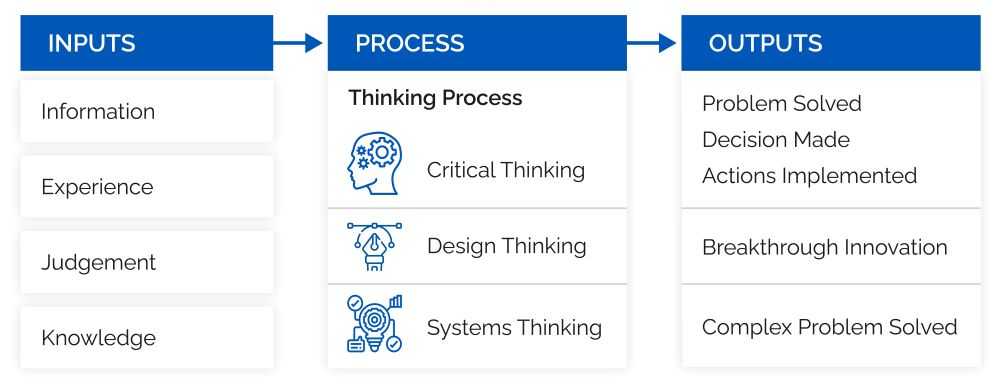The Deep Skills Employees Need
Not long ago, driverless cars, machine learning, 3D printing and AI were only futuristic concepts. Today, we use or anticipate them with some anxiety, as each breakthrough promises to disrupt the way we learn, work, live and play. The age of disruption is here: all economies, industries and businesses are undergoing rapid, fundamental changes.
Advances in automation and technology have brought about what many people call industry 4.0 where smart factories experience increases in productivity with fewer people. In this age of disruption there’s a growing mismatch between the skills needed and the labour supply.
How can businesses, human resource leaders and employees stay relevant? The key lies in developing fundamental thinking skills that are timeless, scalable, adaptable, portable and universally applicable. Advanced thinking skills are essential across industries, functions, sciences, cultures and languages. Unlike subject domain knowledge and technology, thinking skills do not have a half-life, thus making these skills an increasingly precious commodity over time. Singapore’s 2017 Report of the Committee on the Future Economy (CFE) states that, “with the rapid pace of technological development, our workers will need to develop deep skills to stay relevant … to create value, and more importantly ensure that they can utilise their skills effectively on the job”. It is fundamental thinking skills that should form the core of these “deep skills”.
Focus on Fundamental Thinking Skills
In the classic management book The Rational Manager, first published in 1965, Drs. Charles Kepner and Benjamin Tregoe observed that, “The pace of technical change is so great” and the antidote came in the form of advanced thinking skills. These observations have only grown in relevance and thinking skills have been further defined as:
- Critical Thinking (Analytical Thinking)
- Design Thinking (Divergent Thinking)
- Systems Thinking (Holistic Thinking)
The 2023 World Economic Forum (WEF) Future of Jobs Report addresses the changes taking place globally and the specific skills employees will need to be successful in the next few years. The report reinforces the need to focus on improving the quality of thinking and the capabilities to do so. The study reports that analytical thinking and creative thinking remain the most important skills for workers and are growing in importance.
One way to simplify the understanding of fundamental thinking skills is to view it as a process in an input-output model.
In the current age of disruption, inputs (knowledge, technology, etc.) (see figure 1) are rapidly changing. Data is increasing at a pace many times more than that of just two or three years ago. Experience and knowledge are becoming obsolete much faster. Judgment needs to be constantly re-aligned given new developments.

What remains stable and does not change is the thinking process. The faster the rate of change in the inputs, the more we need to rely on a consistent and systematic process to gather, sort, organize and analyze the changes. The key to managing change lies in the thinking process. By having a clear thought process, we can manage not only the change but also harness the collective brainpower of the people in the organization.
Making the Case for Critical Thinking
The WEF Report defines critical thinking as “using logic and reasoning to identify the strengths and weaknesses of alternative solutions, ideas and information to formulate responses to problems” and “the ability to identify, analyse and evaluate situations, ideas and information in order to formulate responses to problems”.
When Kepner and Tregoe spent thousands of hours observing the practices of both effective and ineffective troubleshooters and decision makers, they discovered that successful problem solving and decision making had less to do with organization role and function than the logical process that was used to gather, organize, and analyse information before taking action. These processes not only help to enhance the information, knowledge and experience (i.e. the rapidly changing inputs) but also act as a stabilizing force to allow one to navigate through new situations.
Making the Case for Design Thinking
Critical thinking is particularly important and effective in analyzing situations and converging to a single cause, decision or action. Situations could include investigating a performance deviation (product, service or human) to find the underlying cause or making tough choices based on available options (selecting vendor or buying a business). But what if the situation calls for something game changing and innovative, such as a breakthrough product/service/strategy or a venture into uncharted territory? What if you are trying to disrupt your own business before someone else does? Enter design thinking.
Design thinking is creative problem solving. It is an application of divergent thinking, in a systematic and iterative manner, to achieve groundbreaking innovations. Unlike brainstorming, it is founded on observing (with empathy) how people respond both emotionally and physically before leveraging these observations to derive insights and focus creativity. In his book, Change by Design: How Design Thinking Transforms Organizations and Inspires Innovation, Tim Brown describes design thinking as a discipline that “uses the designer’s sensibility and methods to match people’s needs with what is technologically feasible and what a viable enterprise strategy can convert into customer value and market opportunity”. Design thinking requires a human-centred focus, beginning first and foremost, by identifying people and their needs (Desirability). Only later, during experimentation do ideas and solutions evolve to meet these needs within the requirements of technology (Feasibility) and business (Viability).
This thinking process, used by the renowned design studio, IDEO, guides thinkers from the concrete user experience into the abstract exploration of ideas in response to their needs, and then returns finally to testing those ideas in concrete ways within the user’s context.
With a focus on desirability, viability and feasibility, it can be consistently applied to achieve breakthrough innovation amid rapidly changing environment and technological advances. Brown underscores the value of this kind of thinking: “As long as there is no algorithm that will tell us how to bring divergent possibilities into a convergent reality … accomplished design thinkers will have a place in the world”.
Making the case for Complex Problem Solving (Systems Thinking)
The WEF Report describes complex problem solving as “developed capacities to solve novel, ill-defined problems in complex, real world settings”. The need for this complex problem solving or “systems thinking” is evident in the fusion of IT and technology into virtually every business environment, resulting in increased complexities created by the interdependencies among systems and processes.
Systems thinkers take a holistic perspective when dealing with a complex problem. In his book, Introduction to Systems Thinking, Daniel H. Kim describes systems thinking as “a way of seeing … that helps us better understand and work with systems to influence the quality of our lives”. By viewing the complex problem (business, economic or social problem) as a system, system thinkers develop an appreciation for how the different parts interrelate, balance or reinforce each other.
We can view complex problems from the following multiple levels of perspective: events, patterns, and systemic structures.
Most of us notice events much more easily than patterns or systemic structures even though it is systems that drive the events. This is because we live in an event-oriented world and our language is rooted at the level of events. Our evolutionary history is geared toward responding to events, particularly to events that posed an immediate danger to our well-being. However, it’s redesigning things at the systemic level that offers us far more leverage to control events – to solve complex problems and shape the future rather than simply reacting to events that have happened.
As the world becomes more interconnected, this ability to think beyond the events level and find the right systemic levers to resolve complex problems has become increasingly important.
Case Study
Recognizing that future problems are increasingly complex, involving interdisciplinary solutions, a global technology company developed a cadre of high-potential employees tasked with resolving the most complex and pressing customer experience problems. The team was equipped with three broad sets of skills: Critical Thinking, Design Thinking and Systems Thinking. Over a three-month period of training and coaching, an increasingly self-directed team of independent yet integrated thinkers emerged. The team was successful in cutting incidents of failure experienced by customers in half and established effective work arounds for the majority of the remaining incidents.
Conclusion
In times of unprecedented change and disruption, the only permanent currency is fundamental thinking skills—critical thinking, design thinking and systems thinking. Investments in developing and supporting the application of these thinking skills help both employees and businesses remain relevant, control the future of work and thrive in a changing and uncertain future.
About the author
George Ng (Regional General Manager APAC) is a consulting leader with 20+ years of experience in the areas of strategy, operational and service improvement. As a leader of the Southeast Asia and Greater China team, George works with organizations across the region to achieve impactful operational improvements and sustainable culture changes through the disciplined application of KT thinking processes. gng@kepner-tregoe.com
About Kepner-Tregoe
Kepner-Tregoe has empowered thousands of companies to solve millions of problems. KT provides a data-driven, consistent, scalable approach to clients in Operations, Manufacturing, IT Service Management, Technical Support, and Learning & Development. KT provides a unique combination of skill development and consulting services, designed specifically to reveal the root cause of problems and permanently address organizational challenges. Our approach to problem solving will deliver measurable results to any company looking to improve quality and effectiveness while reducing overall costs. We empower you to solve problems.





